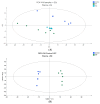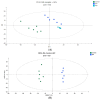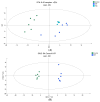Unveiling Lipidomic Alterations in Metabolic Syndrome: A Study of Plasma, Liver, and Adipose Tissues in a Dietary-Induced Rat Model
- PMID: 39458462
- PMCID: PMC11509917
- DOI: 10.3390/nu16203466
Unveiling Lipidomic Alterations in Metabolic Syndrome: A Study of Plasma, Liver, and Adipose Tissues in a Dietary-Induced Rat Model
Abstract
Metabolic syndrome (MetS) is a complex condition characterized by fat accumulation, dyslipidemia, impaired glucose control and hypertension. In this study, rats were fed a high-fat high-fructose (HFF) diet in order to develop MetS. After ten weeks, the dietary-induced MetS was confirmed by higher body fat percentage, lower HDL-cholesterol and increased blood pressure in the HFF-fed rats compared to the normal-fed control animals. However, the effect of MetS development on the lipidomic signature of the dietary-challenged rats remains to be investigated. To reveal the contribution of specific lipids to the development of MetS, the lipid profiling of rat tissues particularly susceptible to MetS was performed using untargeted UHPLC-QTOF-MS/MS lipidomic analysis. A total of 37 lipid species (mainly phospholipids, triglycerides, sphingolipids, cholesterol esters, and diglycerides) in plasma, 43 lipid species in liver, and 11 lipid species in adipose tissue were identified as dysregulated between the control and MetS groups. Changes in the lipid signature of selected tissues additionally revealed systemic changes in the dietary-induced rat model of MetS.
Keywords: adipose tissue; animal model; liver; metabolic syndrome; plasma; untargeted lipidomics.
Conflict of interest statement
The authors declare no conflicts of interest.
Figures







Similar articles
-
Age-dependent effect of high-fructose and high-fat diets on lipid metabolism and lipid accumulation in liver and kidney of rats.Lipids Health Dis. 2013 Sep 18;12:136. doi: 10.1186/1476-511X-12-136. Lipids Health Dis. 2013. PMID: 24044579 Free PMC article.
-
High Fat/High Glucose Diet Induces Metabolic Syndrome in an Experimental Rat Model.Nutrients. 2018 Oct 14;10(10):1502. doi: 10.3390/nu10101502. Nutrients. 2018. PMID: 30322196 Free PMC article.
-
Lipidomic Analysis of Liver and Adipose Tissue in a High-Fat Diet-Induced Non-Alcoholic Fatty Liver Disease Mice Model Reveals Alterations in Lipid Metabolism by Weight Loss and Aerobic Exercise.Molecules. 2024 Mar 27;29(7):1494. doi: 10.3390/molecules29071494. Molecules. 2024. PMID: 38611773 Free PMC article.
-
Effect of High Fructose-Induced Metabolic Syndrome on Tissue Vitamin E and Lipid Peroxide Levels in Rats.J Nutr Sci Vitaminol (Tokyo). 2020;66(2):200-206. doi: 10.3177/jnsv.66.200. J Nutr Sci Vitaminol (Tokyo). 2020. PMID: 32350182
-
The Effects of a Modified High-carbohydrate High-fat Diet on Metabolic Syndrome Parameters in Male Rats.Exp Clin Endocrinol Diabetes. 2018 Apr;126(4):205-212. doi: 10.1055/s-0043-119352. Epub 2017 Nov 8. Exp Clin Endocrinol Diabetes. 2018. PMID: 29117620
References
-
- Paunovic M., Milosevic M., Mitrovic-Ajtic O., Velickovic N., Micic B., Nedic O., Todorovic V., Vucic V., Petrovic S. Polyphenol-Rich Black Currant and Cornelian Cherry Juices Ameliorate Metabolic Syndrome Induced by a High-Fat High-Fructose Diet in Wistar Rats. Heliyon. 2024;10:e27709. doi: 10.1016/j.heliyon.2024.e27709. - DOI - PMC - PubMed
MeSH terms
Substances
LinkOut - more resources
Full Text Sources
Medical

